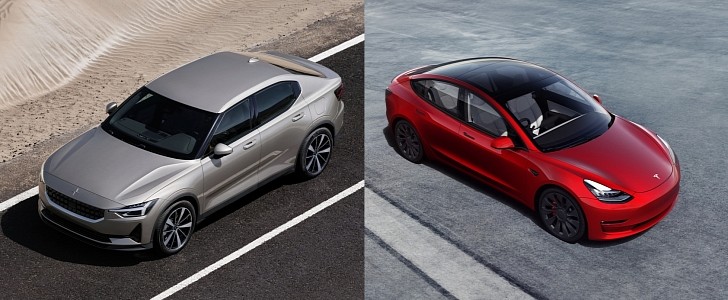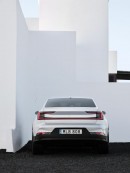The purpose of performing tests with vehicles is to have a fair way to compare them. Magazines around the world do that, as well as some government entities such as EPA. The problem is that EPA presents two different test methods, which makes some companies present different results. This is pretty evident with Edmunds’s range tests with EVs: Tesla failed to beat its EPA numbers again and was joined by Polestar.
The website performs all its tests in the same way: they fully charge the vehicles and drive them until they have about 10 miles left. Edmunds then charges these EVs again and measures how far they were able to travel (the final range minus the range with which the charging session started). Edmunds states it also counts charging losses.
Although it did not disclose how it does that, our bet is that it calculates or checks the amount of kWh the battery pack could receive and subtract it from what the charger presents. These losses are then counted as part of the energy the vehicle requires to run. It would be interesting if Edmunds showed the charging losses in its test results as well.
EPA follows a different procedure. All cars are tested in lab conditions, which is a fantastic thing. If the idea is to put them through the same conditions, using a lab makes it a lot easier. Tests on regular roads or even on tracks have a more significant number of factors that can influence the tests, especially in vehicles as sensitive to variations as electric cars.
EPA puts the cars to a road cycle, an urban cycle, and applies an adjustment factor to them that cuts range by 30%. Carmakers willing to have a more favorable adjustment factor can run their vehicles in three more cycles to get better numbers. Tesla and Audi follow this five-cycle testing. We’re not sure about Polestar.
Despite that, all the three Audi electric cars Edmunds tested still beat their EPA numbers: the e-tron GT, the RS e-tron GT, and the Audi e-tron Sportback. If the German brand also follows the five-cycle testing, why did only Tesla and Polestar fail to exceed their EPA range numbers?
This is not a question we can ask Tesla because it does not talk to the press. However, we have sent Polestar a request for clarification. The company said that another vehicle in Edmunds’s tests which shares the same powertrain and batteries with their vehicle – the 2021 Volvo XC40 Recharge – “performed much more in line with a number we would have expected from the Polestar 2.”
Indeed: the XC40 Recharge has an EPA range of 208 miles (335 km), and Edmunds managed to drive it for 240 miles (385 km). Despite that, Polestar promised to get back to us when it discusses internally what we want to know. According to the company, some of the things we want to understand can be considered sensitive information.
What crosses our mind is that EPA does not perform all these tests. Some manufacturers may do them themselves and just tell the agency the results. If that is the case, this could be the first flaw with EPA’s procedures. There’s a worse one.
If the idea is to compare the vehicles in similar conditions, doing tests in a lab helps a lot. Drag resistance and temperature variations do not harm nor benefit any cars – hence the adjustment factor. We wonder if it takes aerodynamics into consideration. It should. However, having different test procedures does not help compare vehicles fairly.
On top of that, EPA conceived these tests for combustion-engined vehicles. Although aerodynamics play an essential role with them, it is not even close to what it represents with electric cars. A car that fights with the air will offer a much lower range with the limited amount of energy battery packs can offer nowadays.
In that sense, Edmunds's tests are much better for comparing EVs. Those who did their homework with aerodynamics, mass, and rolling resistance will do much better than those who do not care that much about these aspects. In an ideal world, EPA would develop a test cycle that considered that and performed it on its own with all vehicles, submitting all of them to the very same procedures. Apples to apples, but with the same scale.
Although it did not disclose how it does that, our bet is that it calculates or checks the amount of kWh the battery pack could receive and subtract it from what the charger presents. These losses are then counted as part of the energy the vehicle requires to run. It would be interesting if Edmunds showed the charging losses in its test results as well.
EPA follows a different procedure. All cars are tested in lab conditions, which is a fantastic thing. If the idea is to put them through the same conditions, using a lab makes it a lot easier. Tests on regular roads or even on tracks have a more significant number of factors that can influence the tests, especially in vehicles as sensitive to variations as electric cars.
EPA puts the cars to a road cycle, an urban cycle, and applies an adjustment factor to them that cuts range by 30%. Carmakers willing to have a more favorable adjustment factor can run their vehicles in three more cycles to get better numbers. Tesla and Audi follow this five-cycle testing. We’re not sure about Polestar.
Despite that, all the three Audi electric cars Edmunds tested still beat their EPA numbers: the e-tron GT, the RS e-tron GT, and the Audi e-tron Sportback. If the German brand also follows the five-cycle testing, why did only Tesla and Polestar fail to exceed their EPA range numbers?
This is not a question we can ask Tesla because it does not talk to the press. However, we have sent Polestar a request for clarification. The company said that another vehicle in Edmunds’s tests which shares the same powertrain and batteries with their vehicle – the 2021 Volvo XC40 Recharge – “performed much more in line with a number we would have expected from the Polestar 2.”
Indeed: the XC40 Recharge has an EPA range of 208 miles (335 km), and Edmunds managed to drive it for 240 miles (385 km). Despite that, Polestar promised to get back to us when it discusses internally what we want to know. According to the company, some of the things we want to understand can be considered sensitive information.
What crosses our mind is that EPA does not perform all these tests. Some manufacturers may do them themselves and just tell the agency the results. If that is the case, this could be the first flaw with EPA’s procedures. There’s a worse one.
If the idea is to compare the vehicles in similar conditions, doing tests in a lab helps a lot. Drag resistance and temperature variations do not harm nor benefit any cars – hence the adjustment factor. We wonder if it takes aerodynamics into consideration. It should. However, having different test procedures does not help compare vehicles fairly.
On top of that, EPA conceived these tests for combustion-engined vehicles. Although aerodynamics play an essential role with them, it is not even close to what it represents with electric cars. A car that fights with the air will offer a much lower range with the limited amount of energy battery packs can offer nowadays.
In that sense, Edmunds's tests are much better for comparing EVs. Those who did their homework with aerodynamics, mass, and rolling resistance will do much better than those who do not care that much about these aspects. In an ideal world, EPA would develop a test cycle that considered that and performed it on its own with all vehicles, submitting all of them to the very same procedures. Apples to apples, but with the same scale.










































